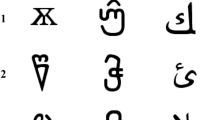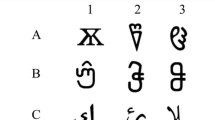Abstract
Reaction time (RT), thought to be important for acquiring a full understanding of the establishment of equivalence classes, has been reported in a number of studies within the area of stimulus equivalence research. In this study, we trained 3 classes of potentially 3 members, with arbitrary stimuli in a one- to-many training structure in 5 adult participants, using a touch screen and software-based recordings. After training the conditional relations, a limited hold (LH) was calculated for each of the 5 participants based on actual RT. Training with a titrating LH in 100-ms steps was conducted until all the participants responded within 1.2 s. Finally, programmed consequences were thinned before testing. We arranged an LH of 2.5 s during the testing for emergent relations. 1 of the 5 participants was found to demonstrate stimulus equivalence. The pattern of increasing RT from baseline trials to symmetry and equivalence test trials was not found.
Similar content being viewed by others
References
ARNTZEN, E. (2004). Probability of equivalence formation: Familiar stimuli and training sequence. The Psychological Record, 54, 275–291.
ARNTZEN, E., BRAATEN, L. F., LIAN, T., & EILIFSEN, C. (2011). Response-to-sample requirements In conditional discrimination procedures. European Journal of Behavior Analysis, 12, 505–522.
ARNTZEN, E., GRONDAHL, T., & EILIFSEN, C. (2010). The effects of different training structures In the establishment of conditional discriminations and the subsequent performance on the tests for stimulus equivalence. The Psychological Record, 60, 437–462.
ARNTZEN, E., & HANSEN, S. (2011). Training structures and the formation of equivalence classes. European Journal of Behavior Analysis, 12, 483–503.
ARNTZEN, E., & LIAN, T. (2010). Trained and derived relations with pictures as nodes. The Psychological Record, 60, 659–677.
ARNTZEN, E., & NIKOLAISEN, S. L. (2011). Establishing equivalence classes In children using familiar and abstract stimuli and many-to-one and one-to-many training structures. European Journal of Behavior Analysis, 12, 105–120.
BARNES, D., & KEENAN, M. (1993). A transfer of functions through derived arbitrary and nonarbitrary stimulus relations. Journal of the Experimental Analysis of Behavior, 59, 61–81. doi: 10.1901/jeab.1993.59-61
BENTALL, R. P., DICKINS, D. W., & FOX, S. R. A. (1993). Naming and equivalence: Response latencies for emergent relations. The Quarterly Journal of Experimental Psychology: Comparative and Physiological Psychology, 46B, 187–214.
DEVANY, J. M., HAYES, S. C., & NELSON, R. O. (1986). Equivalence class formation In language-able and language-disabled children. Journal of the Experimental Analysis of Behavior, 46, 243–257. doi: 10.1901/jeab.1986.46-243
DYMOND, S., & REHFELDT, R. A. (2000). Understanding complex behavior: The transformation of stimulus functions. The Behavior Analyst, 23(2), 239–254.
EILIFSEN, C., & ARNTZEN, E. (2009). On the role of trial types In tests for stimulus equivalence. European Journal of Behavior Analysis, 10, 187–202.
FIELDS, L., ADAMS, B. J., NEWMAN, S., & VERHAVE, T. (1990). The effects of nodality on the formation of equivalence classes. Journal of the Experimental Analysis of Behavior, 53, 345–358. doi: 10.1901/jeab.1990.53-345
FIELDS, L., ADAMS, B. J., VERHAVE, T., & NEWMAN, S. (1993). Are stimuli In equivalence classes equally related to each other? The Psychological Record, 43, 85–105.
HOLTH, P., & ARNTZEN, E. (2000). Reaction times and the emergence of class consistent responding: A case for precurrent responding? The Psychological Record, 50, 305–338.
HORNE, P. J., & LOWE, C. F. (1996). On the origins of naming and other symbolic behavior. Journal of the Experimental Analysis of Behavior, 65, 181–241. doi: 10.1901/jeab.1996.65-185
IMAM, A. A. (2001). Speed contingencies, number of stimulus presentations, and the nodality effect In equivalence formation. Journal of the Experimental Analysis of Behavior, 76, 265–288. doi: 10.1901/jeab.2001.76-265
IMAM, A. A. (2003). Assessing transfer of response speed and nodality via conditional discriminations. Experimental Analysis of Human Behavior Bulletin, 21, 1–7.
MCILVANE, W. J., & DUBE, W. V. (1990). Do stimulus classes form before they are tested? The Analysis of Verbal Behavior, 8, 13–18.
MCILVANE, W. J., & DUBE, W. V. (1996). Naming as the facilitator of discrimination. Journal of the Experimental Analysis of Behavior, 65, 267–272. doi: 10.1901/jeab.1996.65-267
PILGRIM, C. (1996). Can the naming hypothesis be falsified? Journal of the Experimental Analysis of Behavior, 65, 284–286. doi: 10.1901/jeab.1996.65-284
POSNER, M. I. (2005). Timing the brain: Mental chronometry as a tool In neuroscience. Plos Biology, 3, 204–206. doi: 10.1371/journal.pbio.0030051
SAUNDERS, R. R., & GREEN, G. (1999). A discrimination analysis of training-structure effects on stimulus equivalence outcomes. Journal of the Experimental Analysis of Behavior, 72, 117–137. doi: 10.1901/jeab.1999.72-117
SCHATZMAN, K. B., & SCHILLER, N. O. (2004). The word frequency effect In picture naming: Contrasting two hypotheses using homonym pictures. Brain and Language, 90, 160–169. doi: 10.1016/S0093-934X(03)00429-2
SIDMAN, M. (1987). Two choices are not enough. Behavior Analysis, 22, 11–18.
SIDMAN, M. (1994). Equivalence relations and behavior: A research story. Boston, MA: Authors Cooperative.
SIDMAN, M. (2000). Equivalence relations and the reinforcement contingency. Journal of the Experimental Analysis of Behavior, 74, 127–146. doi: 10.1901/jeab.2000.74-127
SIDMAN, M., & TAILBY, W. (1982). Conditional discrimination vs. matching to sample: An expansion of the testing paradigm. Journal of the Experimental Analysis of Behavior, 37, 5–22. doi: 10.1901/jeab.1982.37-5
SPENCER, T. J., & CHASE, P. N. (1996). Speed analysis of stimulus equivalence. Journal of the Experimental Analysis of Behavior, 65, 643–659. doi: 10.1901/jeab.1996.65-643
TOMANARI, G. Y., SIDMAN, M., RUBIO, A. R., & DUBE, W. V. (2006). Equivalence classes with requirements for short response latencies. Journal of the Experimental Analysis of Behavior, 85, 349–369. doi: 10.1901/jeab.2006.107-04
WULFERT, E., & HAYES, S. C. (1988). Transfer of conditional ordering response through conditional equivalence classes. Journal of the Experimental Analysis of Behavior, 125–144. doi: 10.1901/jeab.1988.50-125
Author information
Authors and Affiliations
Corresponding author
Additional information
Silje Haugland is now affiliated with the University of Agder.
Rights and permissions
About this article
Cite this article
Arntzen, E., Haugland, S. Titration of Limited Hold to Comparison in Conditional Discrimination Training and Stimulus Equivalence Testing. Psychol Rec 62, 243–261 (2012). https://doi.org/10.1007/BF03395800
Published:
Issue Date:
DOI: https://doi.org/10.1007/BF03395800




